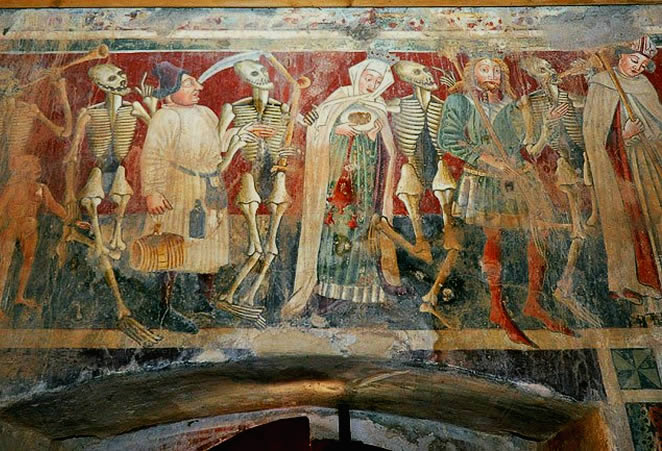DoctorArcanus
The constellation theory has explained these images or icons in the Death card which are connected with the constellation Sagittarius:
A male figure (In the Death card he is a skeleton.)
Hello Cartomancer,
actually, the sex of skeletons seems to me to be as doubtful as that of angels. In Italy and France, Death is typically personified as a woman. Anyway, a skeleton is not the same as a centaur, so the constellation theory fails to explain the most distinctive feature of Death cards.
A horse with a horseman or as part of a centaur
A riding skeleton is not the same as a centaur. The constellation theory poses a new problem here. Where is this centaur in tarot Death cards?
A bow (of Sagittarius the Archer)
Sagittarius MUST have a bow, since he is “the Archer”. Death can have a bow. But, the more distinctive feature of personifications of Death (and of tarot Death card) is the presence of a skeleton or a corpse. This obvious symbolism is very ancient, pre-Christian I think.
Death's bow is possibly related to the Book of Revelation (6,2):
And I saw, and behold a white horse: and he that sat on him
had a bow; and a crown was given unto him: and he went forth
conquering, and to conquer.
A crown in the stars of Corona Australis that is also seen at the feet of the horseman in the Death card
I guess here you are talking of the Waite-Smith tarot? This is not relevant to the origin of Tarot, since that deck is a creation of the XX Century. Actually, we KNOW that Waite derived his Death Card from the Book of Revelation: Death is represented ”by one of the apocalyptic visions”.
A scythe in the stars of Corona Australis (if you accept constellations the Sickle and Scythe)
The scythe and the sickle are related to Death, because Death is related to harvest. See for instance the Book of Revelation (14,18-19):
And another angel came out from the altar, which had power
over fire; and cried with a loud cry to him that had the sharp
sickle, saying, Thrust in thy sharp sickle, and gather the
clusters of the vine of the earth; for her grapes are fully
ripe.
And the angel thrust in his sickle into the earth, and
gathered the vine of the earth, and cast it into the great
winepress of the wrath of God.
When was the scythe first used in the Death card? Was it before or after 1503 AD? That fact could give us an indication of if there was another star map available to the Tarot artist that has been lost, but was the inspiration for the Tarot trumps. The star chart has this name:
Die Karte des Nördlichen Sternenhimmels, Inv.-Nr. Hz 5576, Manoscritto del 1503, Germanisches Nationalmuseum Nürnberg
Here is my mock-up of the constellation Sagittarius in a 1503 star map as the Death card with a scythe. The constellation is flipped horizontally to present it from our vantage point on earth instead of the fashion at the time of presenting a plainsphere from the vantage point of God who is looking in from beyond. This mock-up shows a clear connection between Sagittarius and a scythe (at least on this star map).
http://piecework.deviantart.com/art/Sagittarius-flipped-Hz5576-planisfero-DEATH-394997871
Link to Sagittarius with scythe in hands of Saturn as Father Time:
http://www.atlascoelestis.com/HZ 5576 09.htm
This is a beautiful map: thank you. I greatly enjoy this kind of images!
Death with a Scythe appears in the so-called Charles VI Tarot (likely from Florence, 1450 ca).
In the 1503 illustration, the seven planetary gods (plus Pluto) are associated with the four elements and placed at the corners of the sheet, in order to fill the spaces left by the circular map of the sky. The images of these gods do not belong to the map (obviously, no stars appear on the images of the planetary gods, each of whom represents a single star). Saturn and Venus are associate with element Air, which is placed in the corner closest to Sagittarius.
If I understand correctly what you are saying, you now propose that Death cards are a conflation of the Sagittarius constellation and the planetary god Saturn. This conflation brings in a scythe, but it blurs the meaning of the card (what is this Sagittarius/Saturn hybrid?) without explaining why we have a skeleton on the tarot card. I am afraid I am not following you: I still cannot see any “meaning” in your tarot origin “theory”.


